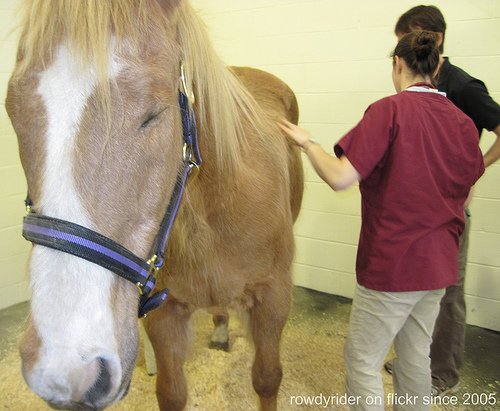
It is important for all horse owners to be able to take their horse’s basic vital signs so they can establish a baseline. Establishing a baseline is important because it allows you to know when something is really wrong with your horse. Here are 4 basic medical evaluations every horse owner should be able to perform.
Lameness Evaluation
If you suspect lameness, you have probably already noticed that your horse is a little off when he walks (or trots or canters). I usually start by confirming this on a flat hard surface like a driveway, preferably a paved driveway, not a gravel one. Many sound horses will wince on gravel driveways and give you a false positive. Have someone else walk and trot the horse in hand straight towards you and away from you. If you first noticed the possible lameness under saddle, have someone repeat the process under saddle.
Pulse
A normal heart rate for adult horses over the age of 3 is 30 to 40 beats per minute. Foals have an average heart rate of 70 to 120 beats per minute. A horse’s heart rate can increase up to 240 beats per minute, but should fall back to 60 beats per minute within 10 to 20 minutes of rest.
You can take your horse’s pulse under his jaw directly below and slightly behind the front corner of your horse’s eye. Count the number of beats you feel in 15 seconds and multiply the number of pulses by four to get beats per minute.
Respiration
The average respiration for a healthy adult horse is 8 to 15 breaths per minute. The respiration rate should never exceed the heart rate. Respiration rate can increase with humidity, fever, or pain.
Taking the respiration rate is easy. Just watch the rise and fall of your horse’s ribcage. Make sure you are counting 1 inhale and 1 exhale as 1 breath, not 2.
Temperature
A horse’s normal temperature should be between 99 and 101 F. You should take your horse’s temperature periodically so you get to know his baseline. A horse’s temperature can vary by 3 degrees depending on environmental factors. Any more than that should prompt a call to the vet.
The best way to take your horse’s temperature is rectally. Yes, you really do have to stick the thermometer in your horse’s butt. Make sure you tie a string to it in case you accidentally let go. Otherwise you might have to call the vet out for a…fishing expedition. Oh boy, wouldn’t that be embarrassing. At least your vet would get a good laugh.
What if I get an abnormal result?
Once you have established a baseline, these tests should be repeated periodically. If you suspect something is wrong or if you get an abnormal result in a regular test, you want to retest to be sure. If you are sure of your findings, call the vet. If in doubt, call the vet anyway and consult with them over the phone. They might tell you it’s ok, but they might also want to come check it out for themselves. Being proactive is always the best approach.
Photo by Rowdy Rider










Thanks for the reminder that it’s important to also consider the checking the rate of respiration when doing medical evaluations. I’d like to get more frequent checkups from now on because I almost passed out from exhaustion while working out a few days ago. I guess my body is no longer at its prime.